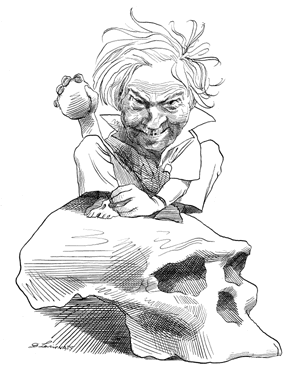It is odd that whereas man’s knowledge of the stars was one of the earliest forms of science his knowledge of his own origins can hardly be called scientific even today. Probably even the most ambitious student of human fossil bones never expected to win a Nobel Prize. It is a study that does indeed stimulate ambition, though not, unfortunately, scientific acumen.
There have been so many excitements over the discovery of fossil man that some of the earlier discoveries are in danger of being forgotten. Dr. Harry Shapiro is a distinguished anthropologist who gives us an excellent account of Peking man, now called Homo erectus, whose remains were discovered in 1926 and lost again in 1941. Often anthropologists have to deal with single isolated skulls or bones but at Peking there were the remains of forty or more individuals, hunter-gathering people living at least 500,000 years ago. A special interest of the find was that some of the animal bones in the cave were burned, so these people knew the use of fire. This fire is actually the earliest evidence of any “cultural” or “intellectual” activities by man, other than the manufacture and use of tools, which also occur in the caves. The brain of Peking man was almost exactly half-way between those of apes and men, so he comes rather close to being the “missing link” that has been so often sought.
The useful pieces of information the Peking fossils give about our ancestors have been rather obscured by the flurry raised over their subsequent loss. The story is recorded in full dramatic detail by Dr. Shapiro. He tells an excellent tale including a very good account of Peking man and how he lived, leading up to the saga of the loss of the bones. In November 1941 they were in the care of a laboratory at the Peking Union Medical College, supported by the Rockefeller Foundation. With the growing menace of war the bones were packed and steps were taken to transfer them for safety to America. But it was too late and Dr. Shapiro recounts the evidence of how the cases were lost when a marine detachment in charge of them was ordered to surrender in December. Were they thrown away by the Japanese, or stolen? Do they still exist? No one knows, but there are some clues, and Shapiro and others are still following them, not without hope.
Sad though this loss may be, we are still left with casts of the bones, useful for many purposes. In any case, more recent finds have pushed our knowledge of man’s origins back long before the Homo erectus stage. Dr. Louis Leakey, who died in 1972, has been responsible more than anyone else for the finds of new evidence. Among the many writings he has given us are two excellent autobiographies. His White African was first published in 1937, and later republished in 1966 and 1973. He called it a “potboiler” written to make money, but its stories of life in Africa are remarkably well told. Now he has given us a sequel that tells how his knowledge as an initiated Kikuyu and friend of Jomo Kenyatta led him to become a criminal detective.
But of course it is as a detective in search of man’s origins that Leakey’s special interest lies. He shows us how he gained his stimulus to study animals and men from seeing them all around him as a boy in Kenya. This made him wonderfully appreciative of all the varied ways of man and beast, but perhaps the very love he had for people and things made it hard for him to look at them with a true scientific detachment. His autobiographies are a joy to read, but they are neither very historical nor very scientific. They tell us much about life in Kenya and about anthropology but do not really provide the clues to why, sadly, Louis Leakey was never fully accepted as a first-rate anthropologist.
He and his wife Mary and son Richard have probably done more than anyone else to provide materials for the study of human evolution. The world of anatomists should be more grateful than it is for these riches. Perhaps the very remoteness of the sites makes it difficult for people used to civilization to realize the difficulties Leakey had to overcome in order to make his earlier finds at Olduvai in Tanzania.
The hardships of the early days can still be reproduced, even if one is fortunate as I was to be flown to Olduvai by Richard Leakey. We took off at dawn from Nairobi airfield between the heads of the giraffes and the bottom of the clouds to sneak down into the Rift Valley and then on over the Ngorongoro crater, one of those that have provided the dust that has preserved the fossil remains. There is no airstrip at Olduvai, only desert. No people were there except Mrs. Mary Leakey and a helper, living all alone in the wild. The valley itself yields bits of the bones and teeth of extinct animals at almost every step. The human remains are rarer, but they have revolutionized our knowledge of man’s origins.
Advertisement
But the Leakeys have not been content only with Olduvai, which would have been enough for most people. Even now Richard Leakey, piloting his own plane and using every possible modern resource, is busily turning up new human fossils every year elsewhere in Africa. And yet in a way, and sadly, new finds instead of consolidating knowledge raise ever fresh controversy. Why is it that in the study of ancestors it is so hard to maintain a scientific objectivity? The subject is interesting but not all that exciting intellectually and certainly not important economically. Perhaps man is so genuinely interested in philosophical questions that when even simple people learn that their species once did not exist they are so amazed that they lose their objectivity in discussing the matter.
Is it this that makes them so ready to accept the news of each fresh find and that tempts the finder to baptize it with a scientific name? Louis Leakey forfeited the sympathy of many scientists by his readiness to invent a new name for each skull—for example, Zinjanthropus, the Nutcracker man. The name of a new genus and species should refer to a population, not an individual, but what is the discoverer to do when his new find seems different from all others? It must have some name or number. Richard Leakey, wiser in his generation, calls his most recent find simply 1470. Each new specimen provides only another clue toward satisfying our interest in our ancestry.
The interest is certainly there, but the subject is actually very much more difficult than it seems on the surface. Can one really imagine the sequence of creatures changing gradually, gradually, gradually from a sort of ape to a sort of man? There never was a first man. There is not one missing link but millions of them. Worse still for the scientists, it is never going to be possible to give clearly identifiable names to the stages of human ancestry. Where there is continuous change there are obviously no sharp breaks. Darwin’s book should really have been called “The Abolition of Species.” It is not a question whether this name or that is correct for a fossil—they never will have “correct” generic and specific names because each “species” changes into the next. The more specimens are discovered the harder the study becomes. One reason that we have a fairly good picture of the evolution of horses is that while there are enough fossils to show the changes there are not too many to confuse us. Where vast numbers of fossils have been preserved the story inevitably becomes hopelessly confused.
What then can we do? Human anatomists are still in considerable confusion in these matters. No one seriously doubts that we have gradually evolved from a nonhuman ancestry, but it is still not clear how best to describe and name the stages. This is indeed a challenging situation and scientists are beginning to respond to it. The possibility of giving an accurate date to fossil finds by the use of isotopes has already transformed the subject. And it now seems that fossils of creatures rather like men may be several million years old. There is evidence that not one but several lines of near humans have existed, only one of which gave rise to Homo sapiens.
To sort out the similarities and differences between fossil fragments we need scientific techniques of measurement. The paleontologists who study these remains have been rather slow to adopt quantitative procedures. In 1953 when asked to address the British Geological Society I spoke on “Morphometry,” the measurement of shape. I can remember the rows of uncomprehending faces. In those days there was not much to say, but I suggested that the problem is that “the eye and brain are good at making single comparisons but less good at comparing one specimen with a series.”
This is what anthropologists have to do when they ask whether a new fossil bone is a “missing link.” Is it more like the corresponding bone of a man or an ape? New mathematical methods for dealing with this very problem, called multidimensional analysis, have been devised. They have been applied to human remains by, among others, Lord Zuckerman and his colleagues when he was at Birmingham. Professor Oxnard gives us some of the results in his book, which will be mandatory reading for all physical anthropologists. Of course as a subject becomes more scientific in this way it gets harder for those who are not specialists to understand it.
Advertisement
Oxnard has made a large series of measurements of the bones of the limbs of the fossil Australopithecines, found in Africa and regarded by many as possible ancestors of man. He uses the new methods to compare the bones with those of various primates with different means of locomotion. He concludes that these fossil creatures did not walk upright quite like men, nor did they go on all fours on their knuckles like great apes. Nor again did they swing in the trees like true “brachiators” such as the gibbons. This seems not to leave very much that they could have done, except to get around by a bit of everything. Oxnard is content to say that they were “unique,” neither man, nor monkey, nor ape. This is not very satisfactory, but it fits with the other evidence in suggesting that the Australopithecines were not in the direct line of evolution that led to Homo sapiens.
Oxnard ends his book with some comments on the implications of the fact that there may perhaps have been several lines of manlike creatures running parallel for millions of years. It means that the human characteristics we are so proud of today have been won in a long struggle. Also that we are much further from animal ancestry than people like Morris and Lorenz seem to think. Man’s society may be very old, and selection may have worked hard to provide brains with the characteristics that make social life possible. It may be that such unpleasant features of man as his tendency to fight with others are not mere relics of animal ancestry but a legacy of the evolutionary competition that has sharpened our intellects. This is of course no justification for war: indeed further understanding of the facts may help us to keep the peace.
But anthropologists will go on searching for more fossil evidence without thinking much about its practical value. Let us hope they will be as skillful and persistent as Louis Leakey and unearth some further populations such as were found and lost at Peking. This might remove the temptation to give fancy names to single fossil skulls.
This Issue
May 29, 1975



